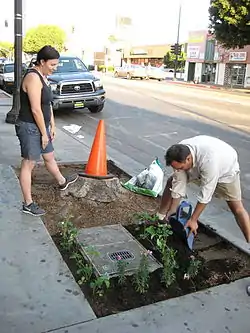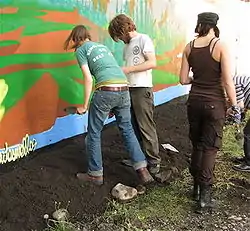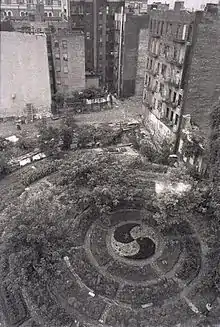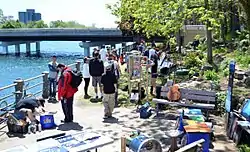Guerrilla gardening
Guerrilla gardening is the act of gardening on land that the gardeners do not have the legal rights to cultivate, such as abandoned sites, areas that are not being cared for, or private property. It encompasses a diverse range of people and motivations, ranging from gardeners who spill over their legal boundaries to gardeners with political influences who seek to provoke change by using guerrilla gardening as a form of protest or direct action. This practice has implications for land rights and land reform; aiming to promote re-consideration of land ownership in order to assign a new purpose or reclaim land that is perceived to be in neglect or misused.

The land that is guerrilla gardened is usually abandoned or perceived to be neglected by its legal owner. That land is used by guerrilla gardeners to raise plants, frequently focusing on food crops or plants intended for aesthetic purposes, like flowers.
Some guerrilla gardeners carry out their actions at night, in relative secrecy, to sow and tend a new vegetable patch or flower garden in an effort to make the area of use and/or more attractive. Some garden at more visible hours for the purpose of publicity, which can be seen as a form of activism.
Etymology

The earliest recorded use of the term guerrilla gardening was by Liz Christy and her Green Guerrilla group in 1973 in the Bowery Houston area of New York. They transformed a derelict private lot into a garden.[1] The space is still cared for by volunteers but now enjoys the protection of the city's parks department. Two celebrated guerrilla gardeners, active prior to the coining of the term, were Gerrard Winstanley, of the Diggers in Surrey, England (1649), and John "Appleseed" Chapman in Ohio, USA (1801).
Guerrilla gardening takes place in many parts of the world—more than thirty countries are documented[2] and evidence can be found online in numerous guerrilla gardening social networking groups and in the Community pages of GuerrillaGardening.org.[3] The term bewildering has been used as a synonym for guerrilla gardening by Australian gardener Bob Crombie.[4]
Examples
International Sunflower Guerrilla Gardening Day
The International Sunflower Guerrilla Gardening Day, scheduled on the 1st of May of every year, is an annual international event when guerrilla gardeners plant sunflowers in their neighborhoods, typically in public places perceived to be neglected, such as tree pits, flower beds and roadside verges.[5] It has taken place since 2007, and was conceived by guerrilla gardeners in Brussels,[6] (who go by the name of The Brussels Farmers). They declared it Journée Internationale de la Guérilla Tournesol. It has been championed by guerrilla gardeners around the world, notably by GuerrillaGardening.org[7] and participation has grown each year since then. Although sunflower sowing at this time of the year is limited to relatively temperate parts of the Northern Hemisphere, this day is also marked in other parts of the world by planting plants appropriate to the season.
North America
Guerrilla gardening continues today, as individuals secretly plant fruit trees, edible perennials, and flowers in parks, along bike trails, etc. Some guerrilla gardeners do so for the purpose of providing food. For example, the Tacamiche banana plantation workers in Honduras illegally grew vegetables on the abandoned plantation land, rather than leave with the plantation's closure in 1995.
Adam Purple's Garden of Eden

From the mid-1970s, Adam Purple created and tended a circular garden (shaped like a yin-yang) in the Lower East Side of Manhattan, in an abandoned lot. In 1986, when it was bulldozed by the City of New York, the garden had overtaken many lots and reached a size of 15,000 square feet.[8][9][10] The short film "Adam Purple and the Garden of Eden" tells its history.[11]
People's Park (Berkeley, California)
People's Park in Berkeley, California is now a de facto public park which was formed directly out of a community guerrilla gardening movement during the late 1960s which took place on land owned by the University of California. The university acquired the land through eminent domain, and the houses on the land were demolished, but the university did not allocate funds to develop the land, and the land was left in a decrepit state.
Eventually, people began to convert the unused land into a park. This led to an embattled history involving community members, the university, university police, Governor Reagan, and the national guard, where protest and bloody reprisal left one person dead, and hundreds seriously wounded. Parts of the park were destroyed and rebuilt over time, and it has established itself into a permanent part of the city.
Greenaid (Los Angeles)
Greenaid is a Los Angeles based organization founded in 2010 by Daniel Phillips and Kim Karlsrud of Common Studio. The organization converts vintage gumball machines to dispense seed balls, a combination of clay, compost and region-specific seeds. Once dispensed, seed balls are tossed or planted in any area that may benefit from wildflowers (Seed bombing). Greenaid partners with business owners, educators and citizens to distribute seedbomb vending machines in various communities worldwide. With region-specific seedbomb mixes, Greenaid aims to integrate and beautify rather than disrupt traditionally bland urban areas such as sidewalks and highway medians.[12] In July 2010, Greenaid received $10,398 in funding from the Kickstarter community. This funding will be used to spread the initiative to new locations and support current operations.[13][14]
L.A. Green Grounds
Designer Ron Finley pioneered the growing produce on a strip of parkway lawn but came into conflict with the city council. He was successful in maintaining this urban market garden and has promoted the idea with a TED talk and appearances at international conferences such as the Stockholm Food Forum and MAD in Copenhagen.[15][16]
SoCal Guerrilla Gardening
Developing the Clean, Green, and Glean method of Guerrilla Gardening, Scott Bunnell has been refining guerrilla gardening methods for over 30 years. In 2008 he started the SoCal Guerrilla Gardening Club, adding more drought tolerant gardens. Having dozens of guerrilla gardens in Los Angeles County. Several gardens in each of the cities of Eagle Rock, Pico Rivera, Whittier, Long Beach, Norwalk, Artesia, Venice, and the Hollywood and Skid Row area of Los Angeles. In 2015 SoCal also planted a guerrilla "satellite" garden in Morro Bay, Ca. with their sister club the Morro Bay Guerrilla Gardening Club.[17][18]
Utah
In Northern Utah, apple trees commonly grow along the banks of canals. Asparagus grows along the smaller ditch banks. Many of these plants were seeded 150 years ago by the workers who dug the canals, by burying their lunch apple core in the freshly dug soil or by surreptitiously spreading seeds along a new ditchbank.
Seattle, Washington
In 2009, as a collaboration between World Naked Bike Ride Seattle, Body Freedom Collaborative, and World Naked Gardening Day, permaculturists Kelda Lorax and Jacob Gabriel launched Gardens Everywhere Bike Parade, a permaculture-themed clothing-optional bike ride that spontaneously showed up at neighborhood gardening locations.
"Guerrilla Park" (Welland, ON, Canada)

Whereas most areas that are subjected to guerrilla gardening are unused or abandoned areas not designated for parkland or green space, this is an exception in that it was initially designed for such a purpose. Originally a maintained parkette in Welland, this small area along the Welland Recreational Waterway fell into disuse and neglect for a number of years. In 2013, a handful of local residents, including visual artists and guerrilla gardeners, reclaimed the space by fully restoring overgrown flower beds, adding outdoor paintings, and overseeing general landscape maintenance. Although this area is officially municipal property, there was initially a question by volunteers as to which local organization was responsible for this parkette's maintenance (whether responsibility fell into hands of Welland Recreational Canal Corporation or City of Welland Parks Department). Volunteers met with representatives of City of Welland, and an unofficial verbal agreement was made, ensuring that although the City of Welland does own the parkette land, volunteers may continue maintenance and gardening in the area. Currently, the area does attract some local artistic, musical, and creative youth. It has also been the setting for a number of small unorganized or impromptu events, such as art shows.[19][20][21]
Arbutus Greenway - Vancouver (BC Canada)
The Arbutus corridor, located on the un-ceded territories of the Musqueam, Squamish and Tsleil Waututh Nations was originally a rail line developed in 1902 by the Canadian Pacific Railway (CPR), connecting Vancouver harbour to the fishing village of Steveston on the South Arm of the Fraser River.[22] In 1905 the BC Electric Company (BCEC) leased and electrified the line to operate interurban passenger rail service between Vancouver and Richmond. The BCEC passenger service was discontinued in 1952 but CPR freight operations continued infrequently until 2001.
With the end of rail operations, CPR wanted to redevelop the 17 hectare corridor for residential and commercial purposes but was prevented by the City of Vancouver which wanted to acquire the lands for green space and potentially, a future light rail transportation line. In 2006, the Supreme Court of Canada affirmed the city's zoning authority to prohibit CPR development,[23] but the final disposition of the lands was not resolved until 2016 when the City of Vancouver purchased the lands from CPR for $55M.
In the interim, home owners adjacent to the unused rail line and community groups had built and maintained numerous gardens and plots on the 9 km route. The homes adjacent to the corridor are large and some of the most expensive in the city with the green space adding to the exclusivity of the properties. In 2014 as negotiations with the city dragged on, CPR began repairing the rail line, clearing the gardens and preparing to run trains on the line. The city filed an injunction to block the railway from reactivating the line, but that bid was dismissed in B.C. Supreme Court.[24] Finally in 2016 the City finalized acquisition of the lands. Terms of the complex purchase agreement included a stipulation that a portion of the corridor must be dedicated for light rail transit use.
This has not entirely ended the conflict over the lands. Since acquiring the Arbutus corridor, the city has built a bike and pedestrian trail and developed an Arbutus Greenway plan but adjacent home owners have pushed for a return to the previous state. Many would like to leave the lands wild and inaccessible which would make the now public lands an exclusive green space for the wealthy adjacent home owners.[25] The official Arbutus Greenway plan has divided the 9 km route into 8 different character zones that will include bicycle and pedestrian paths, public spaces, community gardens, plazas and spaces for public art.
York, Pennsylvania - Downtown East
The Guerrilla Gardeners of Downtown East began in 2009 as a "compact" or agreement between urban flower pot gardeners and residents of the East Market/Broad Street neighborhood in York City, Pennsylvania. Simply put - if residents agreed to keep their sidewalks litter free, and only placed trash out for collection the night before scheduled pick-up, guerrilla gardeners would place a garden pot with flowering annuals in the spring and summer, mums in the fall and greenery over the winter months in place of the trash pile. What began with a few homes and apartments quickly spread and as of 2019 over 40 homes and apartments have agreed to the concept. York City's Guerrilla Gardeners routinely care for street trees, planters and front gardens that have been neglected or fallen into disrepair. Several gardeners focus on litter removal, one ensures street lamps are replaced when they burn out, two focus on seasonal leaf and snow removal. In 2013, Ralph Serpe received the Downtown, Inc. Beautification Award on behalf of the Downtown East Guerrilla Gardeners.
"Garden in a night" (Denmark)
In 1996, Have på en nat ("Garden in a night") was made by the Danish Økologiske Igangsættere ("Organic starters"). An empty piece of land in the middle of the city at Guldbergsgade in Nørrebro, Copenhagen, Denmark, was transformed into a garden in a single night. About 1,000 people took part in the project.[26]
GuerrillaGardening.org (UK)
GuerrillaGardening.org[27] was created in October 2004 by Richard Reynolds as a blog of his solo guerrilla gardening outside Perronet House, a council block in London's Elephant and Castle district. At the time, his motivations were simply those of a frustrated gardener looking to beautify the neighborhood, but his website attracted the interest of fellow guerrilla gardeners in London and beyond, as well as the world's media. Reynolds's guerrilla gardening has now reached many pockets of South London, and news of his activity has inspired people around the world to get involved. He also works alongside other troops, some local and some who travel to participate. He has also guerrilla-gardened in Libya, Berlin and Montreal.
Today, GuerrillaGardening.org is still his blog but also includes tips, links and thriving community[28] boards where guerrilla gardeners from around the world are finding supportive locals. His book, On Guerrilla Gardening,[29] which describes and discusses activity in 30 different countries, was published by Bloomsbury Publishing in the UK and USA in May 2008, in Germany in 2009, France in 2010 and South Korea in 2012. He regularly speaks on the subject to audiences and in 2010 launched a campaign focusing specifically on pavements as an opportunity, to 'plant life in your street'.[30]
Leaf Street Community Garden (Manchester)
Leaf Street is an acre of land in Hulme, Manchester, England, that was once an urban street until turfed over by Manchester City Council. Local people, facilitated by Manchester Permaculture Group, took direct action in turning the site into a thriving community garden.[31]
Kew Bridge Eco Village, London, England
In July 2009, land rights activists moved on to a derelict piece of land near Kew Gardens in West London. Kew Bridge Eco Village was a small community of squatters who grew vegetables and built basic wooden dwellings on the land.
Villi Vyöhyke r.y. (Wild Zone NGO), Finland
Villi Vyöhyke registered association is Finnish nature conservation focused organisation which was founded in Tampere in 2013.[32] Founders of the association started planting meadow plants to road embankments and wastes in urban environments. Urbanization and structural change of agriculture has made many meadow plants endangered in Finland during 20st and 21st centuries. According to members planting wild plants in city area is in gray area according to Finnish law. City of Tampere has reacted positively to the functioning of the association. Villi Vyöhyke has established over 50 guerilla meadows in city of Tampere.[33] The association operates mainly in Pirkanmaa region.
Australia
Guerrilla gardening is prominent in Melbourne where most of the inner northern suburbs have community vegetable gardens; land adjoining rail lines has undergone regeneration of the native vegetation, including nature strips. There are a few minor disputes between guerrilla gardeners in Melbourne, with most falling into one of two groups: those concerned most with native planting and those concerned most with communal food growing. However, people with differing opinions still work together without dispute.[34]
There are small community groups around Australia called "Permablitz" who gather regularly to design and construct suburban vegetable gardens for free, in an effort to educate residents on how to grow their own food and better prepare them if/when food prices become too expensive.
Australian Network 10's show Guerrilla Gardeners featured a team of gardeners who make over areas of council owned property without them knowing.
Kevin Hoffman Walk
Kevin Hoffman Walk is a passive, scenic linear trail with significant indigenous vegetation, lush ground covers, flowering native shrubs and trees, that overlook part of the tranquil Hovells Creek in Lara Victoria. Originally inspired and maintained by Kevin Hoffman and his family in the early 1970s and with the support of the then Shire of Corio they commenced working together.
Vacant Lot Of Cabbages (1978)
In 1978 in downtown Wellington New Zealand artist Barry Thomas, in collaboration with Chris Lipscombe, Hugh Walton and others, planted 180 cabbages "on the demolished Duke of Edinburgh/Roxy Theatre site in the centre of Wellington. This cabbage patch, planted in such a way as to spell the word CABBAGE immediately captured the imagination of both the media and the public and engendered a flurry of other activities on the site, culminating in a week-long festival... when the cabbages were ceremonially harvested."[35] While a work of conceptual sculpture, this intervention is also an early example of guerrilla gardening in New Zealand. Thomas' work remained for six months, "astonishingly unvandalised, as a living, breathing sculpture in the heart of the city."[36] Christina Barton writes that in the months that followed, "it captured the hearts and minds of Wellingtonians, who followed the growth of the cabbages, adding their own embellishments to the site, and contributed to the week of festivities (with poetry readings, performances, and the distribution of free coleslaw) that celebrated their harvest", describing the work as "a provocation to the local council and the city's developers".[37] Thomas' documentation of the project was recently purchased by New Zealand's national gallery Te Papa, who described the work as an "important moment in New Zealand's art and social history" with links to the "Occupy movement, urban farming and guerrilla gardening".[38]
South Korea
Guerrilla gardening in South Korea is organized and carried out by individuals, volunteer groups and Internet communities. Richard Reynolds visited South Korea in August 2012 and spoke to many Korean audiences about guerrilla gardening through TEDxItaewon.[39]
South Africa
The concept of guerilla gardening resonated with a young South African who came across it while living in London. On his return to South Africa, he began implementing the practice by attempting to eradicate invasive wattle trees from Klapperkop Nature Reserve in Pretoria, after local authorities failed to address the infestation. On 20 May 2018 he was however arrested by the South African Police Service for his contribution to society.
Toxicity risks
Due to brownfield, there are some health risks to foraging or planting edible plants near toxic waste sites and roads with heavy traffic due to chemical runoff that gets absorbed by the roots. Scientists have learned that certain types of plants absorb toxins from the soil without dying and can thus be used as a mechanism to reduce chemical ground pollution. Guerrilla gardening could be used as a way to take independent action to clean up one's community, but eating a toxin-absorbent plant will deposit those toxins in the body.
Urban foragers face similar health risks in this manner. Care should be taken to not eat plants that grow in areas where there is known chemical contamination or water pollution. Plants that grow on the side of high-traffic roads should also not be eaten because of automobile fluid runoff.
See also
- Community gardening
- Community Supported Agriculture
- Flower power
- Horticultural therapy
- The Man Who Planted Trees
- Food Justice
- World Naked Gardening Day
General:
References
- Lamborn, P., and Weinberg, B. (Eds.), (1999), Avant Gardening: Ecological Struggle in The City and The World. Autonomedia. ISBN 1-57027-092-9
- Reynolds, R. (2008), On Guerrilla Gardening: A Handbook For Gardening Without Boundaries. Bloomsbury ISBN 978-0-7475-9297-6
- "Index". guerrillagardening.org. Retrieved 2013-06-12.
- "On the verge of a revolution, Sydney Morning Herald, 20 February 2008". Smh.com.au. Retrieved 2013-06-12.
- "International Sunflower Guerrilla Gardening Day". Guerrillagardening.org. Archived from the original on 2008-03-23. Retrieved 2011-01-31.
- "Brussels Farmer: avril 2007". Brussels-farmer.blogspot.com. 2004-02-23. Retrieved 2011-01-31.
- "GGTV International Sunflower Guerrilla Gardening Day Video Tutorial". YouTube. 2010-04-20. Retrieved 2011-01-31.
- "A/N Blog . Video> Exhibition Recalls NY′s Lost Garden of Eden". Blog.archpaper.com. 2011-02-15. Archived from the original on 2013-05-29. Retrieved 2013-06-12.
- Karin Westdyk. "The Garden of Eden: An Environmental "Radical Transformation"". Zentences.com. Retrieved 2013-06-12.
- McKinley, Jesse (22 February 1998). "Adam Purple's Last Stand". The New York Times.
- Moynihan, Colin. "Adam Purple, Eccentric Environmentalist and Gardener in New York, Dies at 84". New York Times. Retrieved 1 October 2015.
- "Greenaid". Commonstudio. Retrieved 2015-07-20.
- "Greenaid". "Kickstarter. Retrieved 2013-06-12.
- Marty Kassowitz (2010-11-14). "GreenAid's Guerrilla Gumball-Machine Gardening - Organic Connections". Organicconnectmag.com. Archived from the original on 2011-11-19. Retrieved 2013-06-12.
- "The veggie king of South Central", Los Angeles Register, May 13, 2014, archived from the original on January 12, 2015, retrieved September 21, 2014
- "Food is MAD", Food Programme, BBC, 21 Sep 2014
- "Guerrilla gardener movement takes root in L.A. area", Los Angeles Times, May 29, 2008
- Guerrilla Gardeners, 2009
- Henschel, Steve (Jun 12, 2014). "Guerrilla Gardeners Transform Park". Niagara This Week.
- Barton, Laura (April 9, 2017). "Canal Side Park Gets Spring Makeover". The Welland Tribune.
- Tribune Staff (May 21, 2015). "Art to Take Over Guerrilla Garden". The Welland Tribune.
- "Arbutus Corridor". Vancouver Heritage Foundation. Retrieved 2019-09-08.
- "Canadian Pacific Railway Co. v. Vancouver (City) - SCC Cases (Lexum)". scc-csc.lexum.com. Retrieved 2019-09-08.
- Robinson, Matthew. "Vancouver buys Arbutus corridor for urban greenway, ending dispute with CP Rail". www.vancouversun.com. Retrieved 2019-09-08.
- "Arbutus Greenway: Exclusion, the Crème de la Crème, and Getting Things Done". Price Tags. 2016-09-08. Retrieved 2019-09-08.
- http://www.information.dk/47309
- "The Guerrilla Gardening Home Page". Guerrillagardening.org. Retrieved 2013-06-12.
- "Community". Guerrillagardening.org. Retrieved 2013-06-12.
- "On Guerrilla Gardening". On Guerrilla Gardening. Retrieved 2013-06-12.
- http://www.pimpyourpavement.com Pimp Your Pavement
- "Archived copy". Archived from the original on 2008-01-01. Retrieved 2007-09-15.CS1 maint: archived copy as title (link)
- "Villi Vyöhyke ry" [Wild Zone NGO] (in Finnish). Retrieved 6 June 2020.
- "Sissiniittyjä kylvävät miehet rakastavat luonnonkukkia: "Tämä on halpa harrastus, kerää vähän siemeniä ja viskoo sinne"" [Men sowing guerrilla meadows love wildflowers: "This is a cheap hobby, collect few seeds and throw them there"] (in Finnish). Yle. Retrieved 6 June 2020.
- The Age, Article "Gardening guerrilla's in our midst", 10/12/08.
- "The Artists' Co-op: Barry Thomas; Eva Yuen; Ian Hunter; Ross Boyd; Terry Handscombe; Robin White". Art New Zealand (Winter, 1978).
- Neil Rowe. "The Artists' Co-op: Barry Thomas; Eva Yuen; Ian Hunter; Ross Boyd; Terry Handscombe; Robin White". Art New Zealand (Winter, 1978).
- Jenny Harper; Aaron Lister, eds. (2007). Wellington: A City For Sculpture. Victoria University Press, 2007. ISBN 9780864735706.
- Sarah Farrar. "'Vacant lot of cabbages' documentation enters Te Papa's archives". Te Papa, Museum of New Zealand.
- TEDx Talks. "Guerrilla gardening -- why people garden without boundaries: Richard Reynolds at TEDxItaewon". Youtube.
External links
| Look up Guerrilla in Wiktionary, the free dictionary. |
| Wikimedia Commons has media related to Guerrilla gardening. |
- GuerrillaGardening.org- The global forum for guerrilla gardeners
- Police vs guerrilla gardeners The Guardian filmed guerrilla gardeners in London encounter the police.
- Allotmenteering Reflections on Guerrilla Gardening and Allotmenteering
- Moss Graffiti How to make moss graffiti
- Domestic Seed Bomb production Richard Reynolds demonstrates the Californian method of seed bomb making.
- Interview with the author of Urban Homestead- Erik Knutzen discusses guerrilla gardening and other collective action.
- Saving the World with Che, Mao, and Carrots - Review of On Guerrilla Gardening by Richard Reynolds for The Atlantic
- Start-Guerrilla-Gardening - Step-by-step guide
- Aktionsgruppe Moos - Guerrilla Gardeners from Vienna, Austria
- 게릴라가드닝 The community for guerrilla gardeners in Korea